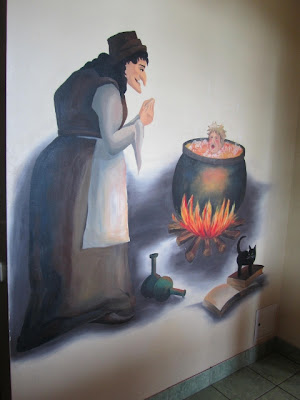Poland has a population of about 38 million and is a relatively wealthy country with plenty of mineral resources and a well developed industry base. It's not a country you hear much about in Australia, si we didn't really know what to expect. What Warsaw has is a well developed western look to it, with an old town close to the centre, and an abundance of historical buildings in excellent condition.
 |
| The view from our hotel room. The Europenas are very good at facades, but often the back is a total wreck. |
 |
| View from level 12 of the hotel. No pedestrain crossings on busy intersections. Walkways under the road are the norm |
However, all is not as it seems. Warsaw was heavily bombed during WWII, and much of the city has been rebuilt exactly as it was before the war, using photos, paintings, recollections and other documents to restore it faithfully. This is especially true of the Old Town.
 |
| These buildings were destroyed in the war and booby trapped by the Nazis. They have been faithfully recreated in the Old Town |
 |
| Part of the Old City Wall |
There were parts of Warsaw which weren't destroyed, and these were the palaces and other similar buildings which were occupied by he Nazis, and were therefore protected.
 |
| Belvedere Palace, built in the 18th century, was destined for destruction, but although holes for explosives were drilled, nothing eventuated. |
 |
| The gates to Warsaw University survived. |
Warsaw has a number of significant statues. One is of Marshall Josef Pilsudski, a WWI patriot, known as Moustache Number 2. Moustache Number 1 was an early King John, and Number 3 is Lech Walesa, the Solidarity leader and retired President. Another is of Frederic Chopin, a son of Warsaw, whose statue was chopped up by the Nazis and recreated in the 1950s.
 |
| Patriot Josef Pilsudski |
 |
| Frederic Chopin, polish pianist, under a weeping willow tree, He gained inspiration from its sounds. |
The monument recognising the Warsaw Ghetto, is a large and powerful. So also is the monument recognising Poles murdered by the Soviets in labour camps in Siberia.
 |
| The front of the Warsaw Ghetto monument. Approx 300 000 Polish Jews were murdered from here. The Jewish population in Poland today is about 1% of pre war numbers. |
 |
| The back of the Jewish Ghetto monument |
 |
| Memorial to those transported to Siberia by the Soviets. |
We saw a film about the destruction of Warsaw by the Nazis, which was quite powerful, but I'm sure the visit to Krakow tomorrow will be even more so.
Our guide, Yolanda, who was excellent, said that Poles had learned to forgive Germany for its actions in World War II since their chancellor Willie Brandt had apologised to the nation, and enabled the country to move forward with cordial relations between the two countries.
Although WWII left its mark, so too has the Soviet era. One of the biggest monuments was built by Stalin and is called the Palace of Culture and Science. It's pretty ugly and is over 200m tall. There are similar ones in Russia and in Riga, but as Yolanda said, "We're very lucky, we only have one. The Soviet Union built it for free, and we have been paying for it ever since." We took the lift up to the 30th level, and the view would have been fantastic on a clear day, but today was drizzly and the view wasn't terrific.
 |
| Stalin's birthday cake |
 |
| The view from level 30 |
Following our trip up Stalin's birthday cake, we had another shopping adventure, trying to buy products by picture, and work out supermarket fresh fruit and veg. protocols, while holding up the queue. I suspect Poles are used to queuing, as the cashiers at Marks and Spencer were as slow as a wet week as well.
Well, that's Warsaw. Off to Krakow tomorrow.























































